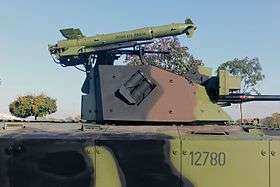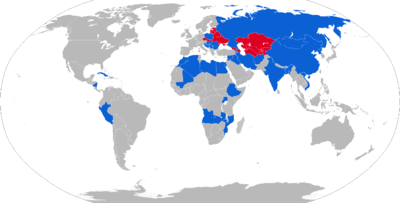9M14 Malyutka
| 9M14 Malyutka AT-3 Sagger | |
|---|---|
|
Improved Serbian-produced 9M142T missile | |
| Type | Anti-tank missile |
| Place of origin | Soviet Union |
| Service history | |
| In service | 1963–present |
| Used by | Soviet Union and others |
| Wars |
Vietnam War Yom Kippur War Western Sahara War Ethiopian Civil War Lebanese Civil War[1] Iran–Iraq War Gulf War Croatian War of Independence 2006 Lebanon War First Chechen War Second Chechen War (by Chechen militants) Libyan Civil War Syrian Civil War Iraqi Civil War (2014–present)[2] Yemeni Civil War (2015-present) Saudi Arabian-led intervention in Yemen (2015-present) Conflict in Najran, Jizan and Asir |
| Production history | |
| Designer | Design Bureau of Machine-Building (KBM, Kolomna) |
| Designed | 1961–1962 |
| Manufacturer | Soviet Union, Russia as successor state and other countries under license and domestic versions |
| Produced | 1963 |
| Variants | 9M14M, 9M14P1, Malyutka-2, Malyutka-2F |
| Specifications | |
| Weight |
10.9 kg (9M14M) 11.4 kg (9M14P1) 12.5 kg (Malyutka-2) ~12 kg (Malyutka-2F) |
| Length |
860 mm 1,005 mm combat ready (Malyutka-2) |
| Width | 393 mm (wingspan) |
| Diameter | 125 mm |
|
| |
| Effective firing range | 500–3,000 m |
| Warhead weight |
2.6 kg (9M14M, 9M14P1) 3.5 kg (Malyutka-2, Malyutka-2F) |
|
| |
| Speed |
115 m/s (410 km/h) (9M14M, 9M14P1) 130 m/s (470 km/h) (Malyutka-2, Malyutka-2F)[3] |
Guidance system | MCLOS, SACLOS (Later variants) |
The 9M14 Malyutka (Russian: Малютка; "Little one", NATO reporting name: AT-3 Sagger) is a manual command to line of sight (MCLOS) wire-guided anti-tank guided missile (ATGM) system developed in the Soviet Union. It was the first man-portable anti-tank guided missile of the Soviet Union and is probably the most widely produced ATGM of all time—with Soviet production peaking at 25,000 missiles a year during the 1960s and 1970s. In addition, copies of the missile have been manufactured under various names by at least five countries.
Since supplemented by more advanced anti-tank guided missiles, the Sagger and its variants have seen widespread use in nearly every regional conflict since the 1960s.
Development
Development began in July 1961 with the government assigning the project to two design teams: Tula and Kolomna. The requirements were:
- Vehicle mountable and/or man portable
- Range of 3,000 meters
- Armor penetration of 200 millimetres at 60°
- Maximum weight of 10 kilograms
The designs were based on the Western ATGMs of the 1950s, such as the French ENTAC and the Swiss Cobra. In the end, the prototype developed by the Kolomna Machine Design Bureau, who were also responsible for the AT-1 Snapper, was chosen. Initial tests were completed by 20 December 1962, and the missile was accepted for service on 16 September 1963.
Description
The missile can be fired from a portable suitcase launcher (9P111), ground vehicles (BMP-1, BRDM-2) and helicopters (Mi-2, Mi-8, Mi-24, Soko Gazelle). The missile takes about five minutes to deploy from its 9P111 fibreglass suitcase, which also serves as the launching platform.
The missile is guided to the target by means of a small joystick (9S415), which requires intensive training of the operator. The operator's adjustments are transmitted to the missile via a thin three-strand wire that trails behind the missile. The missile climbs into the air immediately after launch, which prevents it from hitting obstacles or the ground. In flight, the missile spins at 8.5 revolutions per second—it is initially spun by its booster, and the spin is maintained by the slight angle of the wings. The missile uses a small gyroscope to orient itself relative to the ground; as a result, the missile can take some time to bring back in line with the target, which gives it a minimum range of between 500 and 800 m. For targets under 1,000 m, the operator can guide the missile by eye; for targets beyond this range the operator uses the 8x power, 22.5 degree field of view 9Sh16 periscope sight.
The engagement envelope is a 3 km, 45 degree arc centered on the missile's launch axis. At ranges under 1.5 km, this arc reduces until, at the 500 m range, the missile can only hit targets 50 m either side of the center line. Accuracy falls off away from the launch axis—falling to approximately half its optimal accuracy at the extremes.
While early estimates of the missile hitting the target ranged from 60 to 90%, experience has shown that it can drop to an efficiency between 2 and 25% in case of less than optimal conditions and lack of skill from the operator. In fact, MCLOS requires considerable skill on the part of the operator: according to some sources, it takes 2,300 simulated firings to become proficient with the missile as well as 50 to 60 simulated firings a week to maintain the skill level. Nevertheless, the weapon has always been quite popular with its operators and has enjoyed a constant updating effort both in the Soviet Union/Russia and in other countries.
The two most serious defects of the original weapon system are its minimum range of between 500 and 800 m (targets that are closer cannot be effectively engaged) and the amount of time it takes the slow moving missile to reach maximum range—around 30 seconds—giving the intended target time to take appropriate action, either by retreating behind an obstacle, laying down a smoke-screen, or by returning fire on the operator.
Later versions of the missile addressed these problems by implementing the much easier to use SACLOS guidance system (though only available for ground vehicle and helicopter mounts), as well as upgrading the propulsion system to increase the average flight speed. The latest updates sport tandem warheads or probes in order to counteract explosive reactive armor, as well as thermal imaging systems. Even in these latest version, the Malyutka is probably the most inexpensive ATGM in service, with unitary price caps in the order of hundreds of dollars instead of the tens of thousands of the latest third generation models.

History
In Soviet service, the man-portable version was deployed as part of the anti-tank platoon of motor rifle battalions. Each platoon had two Malyutka sections, each with two teams. Each team had two launcher stations. One assistant gunner in each team served as an RPG-7 gunner. The RPG-7 was needed to cover the 500 meter deadzone created by the minimum range of the missile.
It is also an integrated part of the BMP-1, BMD-1, and BRDM-2 vehicles.

Vietnam War
On 23 April 1972, the recently organized Army of the Republic of Vietnam 20th Tank Regiment was attacked by the NVA (North Vietnamese Army) employing the 9M14M Malyutka anti-tank guided missile for the first time.[4] The 20th was the only South Vietnamese armor unit equipped with the M48 Patton tank. This first employment of the Malyutka destroyed one M48A3 and one M113 armored cavalry assault vehicle (ACAV), and a second ACAV was damaged.[5]
During this engagement with the weapon, the ARVN tankers appeared fascinated by the missile's slow and erratic flight,[6] but through experience, they soon deployed counter measures against the weapon system. Upon launching by the enemy, ARVN crewmen would fire all their weapons towards the Sagger's firing position, which would make the gunner flinch and lose control of his missile. Although the gunner could take cover away from the launch site, the joystick control wire only allowed 15 meters of clearance. During the engagement, the ARVN eventually lost eight tanks to the 9M14M missile, but had developed tactics to defend themselves against it.[4]
During the Battle of Cửa Việt, the PAVN put up fierce resistance to the attack, destroying 26 M-48s and M-113s with AT-3 missiles.[7]
Yom Kippur War
The missile was employed by Arab armies during the initial phases of the Yom Kippur War.[8] Later in the war, the Israelis adopted new tactics and learned to neutralize the Sagger threat by employing large concentrations of artillery fire to either distract or kill the Sagger operators.[8] Other improvised methods used by the Israelis to defeat the Saggers involved firing in front of the tank to create dust, moving back and forth and firing at the source of Sagger fire.[9] These Israeli tactics were later adopted by NATO forces to counter the threat posed by Warsaw Pact ATGMs.[9] In total, Saggers knocked out more than 800 Israeli tanks and other combat vehicles during the war.[10]
Libyan Civil War
Rebels of the Free Libyan Army have been filmed using Saggers during the Libyan Civil War.[11][12]
Syrian Civil War
Syrian rebels have also uploaded videos of their Sagger firings against government forces since late 2012.[13]
Models

- AT-3 Sagger
- AT-3A Sagger A 9M14 Malyutka wire-guided MCLOS Entered service in 1963.
- AT-3B Sagger B 9M14M Malyutka-M wire-guided MCLOS Entered service in 1973 improved motor, reducing flight time to maximum range. Mass 11 kg. Range 3 km.
- AT-3C Sagger C 9M14P Malyutka-P wire-guided SACLOS
- 9M14P Improved warhead 460 mm versus RHA, Entered service in 1969
- 9M14P1 Improved warhead 520 mm versus RHA with a stand off probe for improved capability against ERA.
- 9M14MP1
- 9M14MP2
- AT-3D Sagger D wire-guided SACLOS entered service in the 1990s. Mass 13 kg. Range 3 km. Speed improved to 130 m/s.
- 9M14-2 Malyutka-2 3.5 kg HEAT warhead 800 mm penetration versus RHA. Entered service in 1992. Weight 12.5 kg.
- 9M14-2M Malyutka-2M 4.2 kg tandem HEAT warhead for improved capability against ERA. Weight 13.5 kg. Speed 120 m/s.
- 9M14-2P Malyutka-2P
- 9M14-2F Malyutka-2F 3.0 kg thermobaric warhead. Intended for use against troops and soft vehicles.
- 9M14P-2F
- 9M14-2T[14] Serbian VTI Malyutka-2T SACLOS 4.4 kg tandem HEAT warhead 1,000 mm penetration versus RHA, improved capability against ERA. Weight 13.7 kg. Speed 120 m/s.[15]
- 2T5 Serbian VTI Malyutka-2T5 range 5 kilometers, guided missile via radio control.
- HJ-73 Hongjian Red Arrow-73 China
- RAAD Iran
- RAAD AT-3B clone
- RAAD-T tandem HEAT warhead
- I-RAAD SACLOS
- I-RAAD-T SACLOS tandem HEAT warhead
- Susong-Po North Korean
- Maliutka M2T Romania, joint ELMEC and Euromissile project, uses MILAN 2T tandem warhead capable of defeating ~900mm of RHA.[17]
- Kun Wu 1 Taiwan
Production

The Malyutka and modern derivatives are still produced in several versions in following countries:
- North Korea – domestic version Susong-Po
- Iran – domestic version RAAD
- Serbia – few domestic modernised versions with different types of warheads, range and guidance
- Vietnam – under license from Serbia version with improved SACLOS guidance
- China – HJ-73 variants
- Romania – Malyutka M2T
- Egypt – under licence
Operators
Current operators












































Non-state operators













Former operators















- Union of Forces for Democracy and Development[28]

.svg.png)
See also
Notes
- ↑ "Batailles de chars au Liban". Encyclopédie des armes : Les forces armées du monde (in French). I. Atlas. 1986. p. 16.
- ↑ "Iraqi forces use AT-3 Sagger anti-tank guided missiles to destroy ISIS sniper nests north of Samarra". Retrieved 25 Aug 2015.
- ↑ "Btvt.narod.ru". Retrieved 13 November 2014.
- 1 2 Dunstan
- ↑ Starry Archived 16 December 2008 at the Wayback Machine.
- ↑ Starry p. 210, 211
- ↑ Melson, Charles (1991). U.S. Marines In Vietnam: The War That Would Not End, 1971–1973. History and Museums Division, Headquarters, U.S. Marine Corps. pp. 129–131. ISBN 978-1482384055. P. 135
- 1 2 Tucker, Spencer, C, The Encyclopedia of Middle East Wars, ABC-CLIO, LLC, (Santa Barbara California, 2010), p. 158, ISBN 978-1-85109-947-4
- 1 2 Rabinovich, Abraham, The Yom Kippur War: The Epic Encounter That Transformed The Middle East, Random House, p.140
- ↑ "PTUR suhoputnih voisk", G.N.Dmitriev, Arhiv-Press, 1997, pp.10(Russian:ПТУР Сухопутных войск / Под ред. Г. Н. Дмитриева. — Киев: Архив-Пресс, 1997. — С. 10. — (Архив 500+). — 700 экз.)
- ↑ "Misratah - AL DAFNIA BATTLE 6". YouTube. Retrieved 13 November 2014.
- ↑ "صاروخ سعدون - YouTube". YouTube. Retrieved 13 November 2014.
- ↑ "YouTube". Retrieved 20 May 2015.
- ↑ "MTI develops longer-range Malyutka 2T - Jane's 360". www.janes.com.
- ↑ "МАLYUTKA - 2 ANTI-TANK GUIDED MISSILE FAMILY - SDPR - Yugoimport". www.yugoimport.com.
- ↑ China has delivered HJ-73D anti-tank missile systems and assault rifles to South Sudan - Armyrecognition.com, 15 July 2014
- ↑ ELMEC website Archived 26 July 2010 at the Wayback Machine.
- 1 2 3 4 5 6 7 8 9 10 11 "Trade Register". Stockholm International Peace Research Institute.
- ↑ "9M14". www.deagel.com.
- 1 2 3 4 5 6 7 8 9 10 11 12 13 14 15 16 17 18 19 20 21 22 23 24 25 26 27 28 29 30 31 International Institute for Strategic Studies (IISS) (14 February 2018). "The Military Balance 2018". The Military Balance. Routledge. 118.
- ↑ FAS report on AT-3 SAGGER Anti-Tank Guided Missile
- 1 2 3 "Future Artillery Systems: 2016 Market Report" (PDF). Tidworth: Defence IQ. 2016. Archived from the original (PDF) on 5 August 2016. Retrieved 21 January 2017.
- ↑ "آشنایی با موشکهای ضد زره ایران". hamshahrionline.ir. Retrieved 2 June 2017.
- ↑ Salvador López de la Torre (20 November 1984). "El fracaso militar del Polisario: Smul Niran, una catástrofe de la guerrilla". ABC (in Spanish). pp. 32–33.
- 1 2 3 International Institute for Strategic Studies, The Military Balance, 2017
- ↑ "Armed Actor Research Notes: Armed Groups' Holding of Guided Light Weapons. Number 31, June 2013" (PDF). Small Arms Survey.
- ↑ Fulan Nasrullah (9 August 2014). "9th And 10th August Nigeria SITREP (Boko Haram)".
- 1 2 3 4 5 6 "Guided light weapons reportedly held by non-state armed groups 1998-2013" (PDF). Small Arms Survey. March 2013.
- ↑ https://twitter.com/Mansourtalk/status/972971281367920640
- ↑
- ↑ Said Khatib. "Palestinian militants from the Al-Quds Brigades, the armed wing of..." AFP/Getty Images.
- ↑ "Iraq: Turning a blind eye: The arming of the Popular Mobilization Units" (PDF). Amnesty International. 5 January 2017.
References
- Hull, A.W., Markov, D.R., Zaloga, S.J. (1999). Soviet/Russian Armor and Artillery Design Practices 1945 to Present. Darlington Productions. ISBN 1-892848-01-5.
- Противотанковый ракетный комплекс "Малютка" (9К14/9К11) (in Russian)
- ПТУР первого поколения в АОИ, by Oleg Granovsky (in Russian)
- ПТРК 9К11/9К14 «Малютка» (in Russian)
- Starry, Donn A., General. Mounted Combat In Vietnam. Vietnam Studies; Department of the Army. First printed 1978-CMH Pub 90-17.
- Dunstan, Simon. Vietnam Tracks-Armor In Battle. 1982 edition, Osrey Publishing; ISBN 0-89141-171-2.
External links
| Wikimedia Commons has media related to 9K11 Malyutka. |